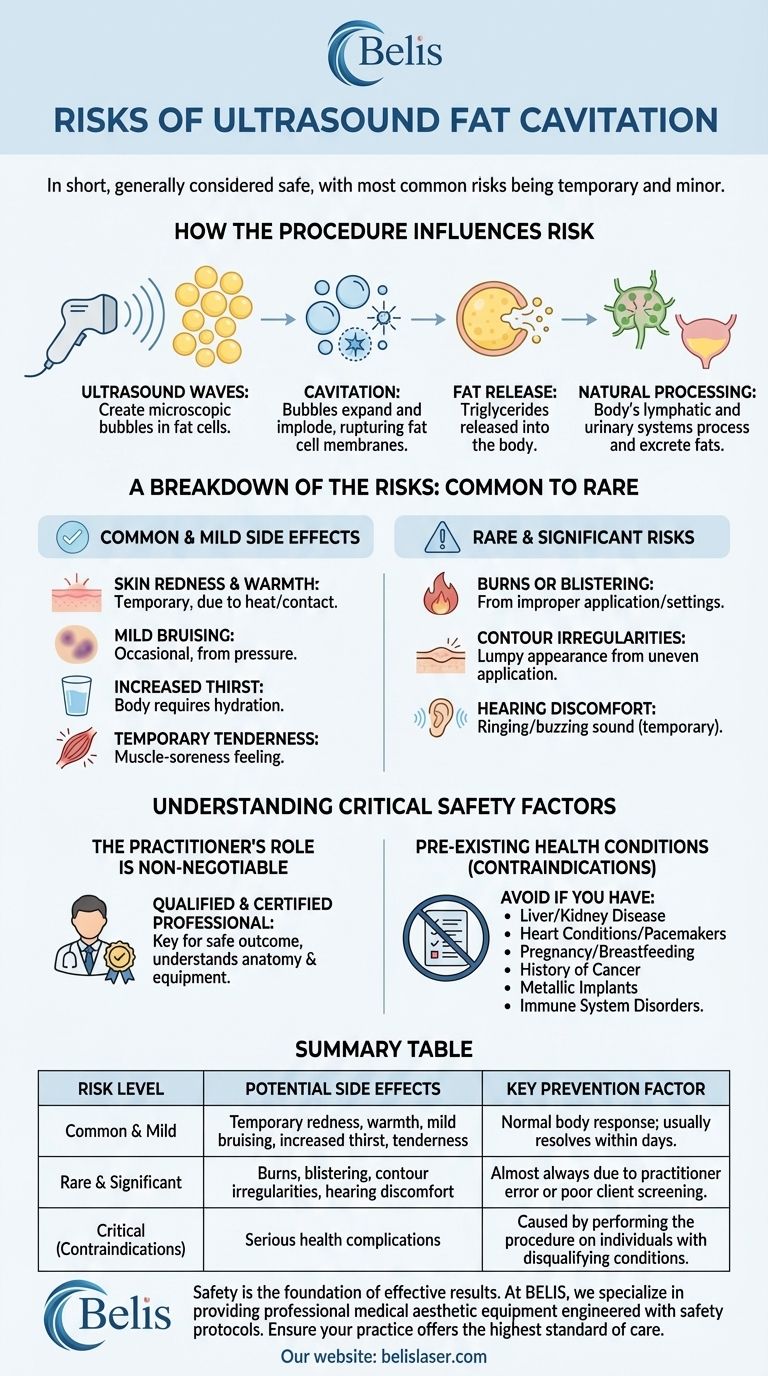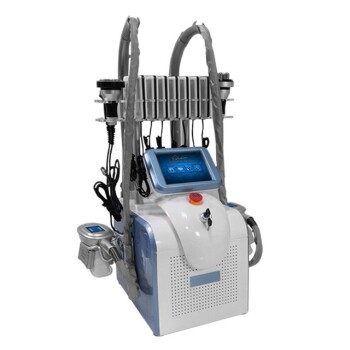In short, ultrasound fat cavitation is generally considered safe, with the most common risks being temporary and minor. These typically include localized redness, mild bruising, and a feeling of warmth or tenderness in the treated area, all of which usually resolve within a few days.
The safety of ultrasound cavitation is not determined by the technology alone, but by the intersection of a qualified practitioner and a suitable candidate. The most significant risks arise when the procedure is performed by an untrained individual or on a person with disqualifying health conditions.

How the Procedure Influences Risk
To understand the risks, you must first understand the mechanism. Ultrasound cavitation uses low-frequency sound waves to create microscopic bubbles within the subcutaneous fat cells.
These sound waves cause the bubbles to rapidly expand and contract, eventually imploding. This process, known as cavitation, ruptures the fat cell membrane, releasing its contents (triglycerides) into the body.
Your body's lymphatic and urinary systems then naturally process and excrete these released fats. This mechanism is key to understanding both the side effects and the more serious contraindications.
A Breakdown of the Risks: From Common to Rare
The potential risks fall into two distinct categories: common, low-impact side effects and rare complications often tied to practitioner error.
Common and Mild Side Effects
These are temporary and generally considered a normal part of the body's response to the treatment.
- Skin Redness and Warmth: The ultrasound handpiece generates heat and requires firm contact with the skin, which can cause temporary redness and a warm sensation.
- Mild Bruising: The pressure applied during treatment and the underlying cellular disruption can occasionally lead to minor bruising.
- Increased Thirst: Your body requires adequate hydration to help the liver and kidneys process the released fatty acids. This can manifest as a noticeable increase in thirst post-treatment.
- Temporary Tenderness: The treated area may feel tender to the touch for a day or two, similar to muscle soreness after a workout.
Rare but More Significant Risks
These are not inherent to the procedure itself but are almost always the result of improper application or poor client screening.
- Burns or Blistering: This is a serious but rare risk caused by an inexperienced operator leaving the applicator on one spot for too long or using incorrect power settings.
- Contour Irregularities: Uneven application of the ultrasound energy can lead to a lumpy or dimpled appearance. A skilled technician ensures smooth, consistent passes to prevent this.
- Hearing Discomfort: Some clients report a ringing or buzzing sound in their ears during treatment. This is the sound of the low-frequency ultrasound waves resonating in the body and is temporary.
Understanding Critical Safety Factors
The most significant risks are not side effects but contraindications—the reasons a person should not undergo the procedure at all.
The Practitioner's Role is Non-Negotiable
The single most important factor for a safe outcome is the person performing the procedure. A qualified and certified professional understands the anatomy, knows how to operate the equipment correctly, and can properly screen clients for health risks.
Pre-existing Health Conditions (Contraindications)
Because the procedure relies on your body's metabolic systems to clear the released fat, individuals with certain conditions should avoid it entirely. These include:
- Liver or kidney disease
- Heart conditions or pacemakers
- Pregnancy or breastfeeding
- History of cancer
- Presence of metallic implants (like IUDs or plates) in the treatment area
- Disorders of the immune system
Making an Informed Decision
Ultimately, mitigating risk comes down to ensuring the procedure is right for you and is performed by the right person.
- If your primary focus is safety: Your first step is to verify the practitioner's certification and experience, and to have a thorough consultation to discuss your full health history.
- If your primary focus is achieving results: Understand that this is a contouring tool, not a weight-loss method, and commit to the full series of recommended treatments while maintaining a healthy diet and hydration.
Making an informed choice begins with understanding that your own health and your practitioner's expertise are the most critical components of a safe and effective outcome.
Summary Table:
| Risk Level | Potential Side Effects | Key Prevention Factor |
|---|---|---|
| Common & Mild | Temporary redness, warmth, mild bruising, increased thirst, tenderness | Normal body response; usually resolves within days. |
| Rare & Significant | Burns, blistering, contour irregularities, hearing discomfort | Almost always due to practitioner error or poor client screening. |
| Critical (Contraindications) | Serious health complications | Caused by performing the procedure on individuals with disqualifying conditions (e.g., liver/kidney disease, pregnancy). |
Safety is the foundation of effective results. The single most important factor in a safe ultrasound cavitation treatment is the expertise of the practitioner and the quality of the equipment.
At BELIS, we specialize in providing professional medical aesthetic equipment to clinics and premium beauty salons. Our advanced, reliable devices are engineered with safety protocols to help qualified practitioners deliver optimal, low-risk outcomes for their clients.
Ensure your practice offers the highest standard of care. Contact our experts today to learn how BELIS equipment can enhance your service safety and efficacy.
Visual Guide

Related Products
- Ultrasonic Cavitation Radiofrecuency Machine for Body Slimming
- EMSlim Body Sculpting Machine EMS Body Slimming Machine
- EMSlim RG Laser Body Sculpting and Slimming Machine
- Cryolipolysis Fat Freezing Machine Ultrasonic Cavitation Fat Reducing Device
- Cryolipolysis Fat Freezing Machine and Ultrasonic Cavitation Device
People Also Ask
- What are the negative side effects of cavitation? Understanding the Risks for Your Practice
- What does a cavitation machine do for your body? Sculpt Your Contours Without Surgery
- Does ultrasound really break down fat? Discover the Science of Non-Invasive Fat Reduction
- Does cavitation destroy fat cells permanently? Yes, for targeted, stubborn fat reduction.
- What are the restrictions for cavitation? Ensure Your Safety and Treatment Success



















